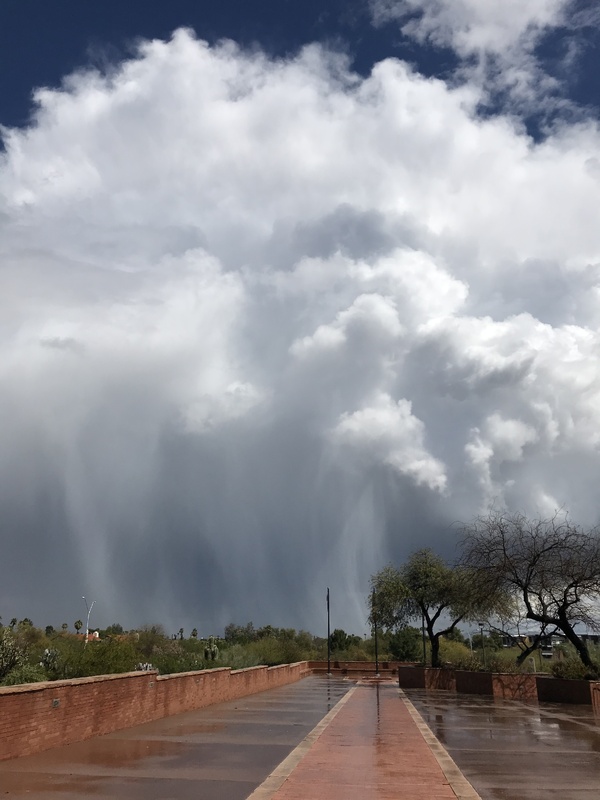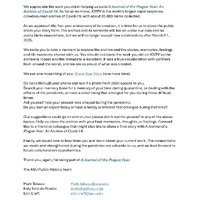Item
How I got involved with A Journal of the Plague Year
Title (Dublin Core)
How I got involved with A Journal of the Plague Year
Description (Dublin Core)
In March 2020, I was working with two other history graduate students on an oral history project of an international non-profit agency. We'd conducted several interviews, and had some scheduled for the week of Spring Break, March 9-13. COVID-19 turned into a real thing that week; the number of cases seemed to be escalating, schools and universities were starting to shut down, all capped off on Wednesday, March 11, with the World Health Organization declaring that a global pandemic was underway.
I had an oral history interview scheduled in downtown Phoenix late in the morning of Friday the 13th. I doubted whether the interview would really go forward, but had not gotten the word that it was cancelled. I booked a rideshare to head downtown for the interview. As we were headed down the freeway, a rather freakish thunderstorm started, unusual for that time of year. When I was about halfway downtown, I finally got the word that the interview was cancelled. To not waste the ride, I re-directed the driver to the Arizona Historical Society in north Tempe, where I needed to pick up some things for some other work I was doing. The historical society was open, but there were very few people there. I picked up what I needed, and decided to walk from there across the river to campus, where I could meet my wife and get a ride home. As I left, the storm clouds were pretty dramatic, and I took the attached photo.
On my walk I crossed the Mill Avenue bridge and passed Tempe Beach Park. Workers were taking down the tents and other equipment for the St. Patrick's day festival, which the city had just cancelled. I got to my wife's office, and we went home.
As it happened, my wife was on her last day before moving to a position at another department at ASU. She reported there Monday morning and was sent home with everyone else in her office by noon. Also, my son was home for Spring Break from the University of Arizona that week, and he never went back that semester.
When I got home that Friday, I found that my colleagues on the oral history project and I had gotten emails from Drs. Mark Tebeau and Catherine O'Donnell about a new project, which they were calling "A Journal of the Plague Year." The idea was to start a historical archive of what we could already see was an event of significant historical impact. This archive would come from the contributions of ordinary people, not content selected by archivists.
I was happy to jump over to this new project. It gave me a new project for the semester, but above all it was very interesting work on a very innovative project. Over the next few weeks, I started working with the team curating the new collection, which grew rapidly to thousands of items. The number of volunteers expanded beyond ASU, and I found myself working with people from other institutions around the world.
That Friday the 13th stands out for me as the day the pandemic closed everything down, but also opened up opportunities.
I had an oral history interview scheduled in downtown Phoenix late in the morning of Friday the 13th. I doubted whether the interview would really go forward, but had not gotten the word that it was cancelled. I booked a rideshare to head downtown for the interview. As we were headed down the freeway, a rather freakish thunderstorm started, unusual for that time of year. When I was about halfway downtown, I finally got the word that the interview was cancelled. To not waste the ride, I re-directed the driver to the Arizona Historical Society in north Tempe, where I needed to pick up some things for some other work I was doing. The historical society was open, but there were very few people there. I picked up what I needed, and decided to walk from there across the river to campus, where I could meet my wife and get a ride home. As I left, the storm clouds were pretty dramatic, and I took the attached photo.
On my walk I crossed the Mill Avenue bridge and passed Tempe Beach Park. Workers were taking down the tents and other equipment for the St. Patrick's day festival, which the city had just cancelled. I got to my wife's office, and we went home.
As it happened, my wife was on her last day before moving to a position at another department at ASU. She reported there Monday morning and was sent home with everyone else in her office by noon. Also, my son was home for Spring Break from the University of Arizona that week, and he never went back that semester.
When I got home that Friday, I found that my colleagues on the oral history project and I had gotten emails from Drs. Mark Tebeau and Catherine O'Donnell about a new project, which they were calling "A Journal of the Plague Year." The idea was to start a historical archive of what we could already see was an event of significant historical impact. This archive would come from the contributions of ordinary people, not content selected by archivists.
I was happy to jump over to this new project. It gave me a new project for the semester, but above all it was very interesting work on a very innovative project. Over the next few weeks, I started working with the team curating the new collection, which grew rapidly to thousands of items. The number of volunteers expanded beyond ASU, and I found myself working with people from other institutions around the world.
That Friday the 13th stands out for me as the day the pandemic closed everything down, but also opened up opportunities.
Date (Dublin Core)
Creator (Dublin Core)
Contributor (Dublin Core)
Event Identifier (Dublin Core)
Partner (Dublin Core)
Type (Dublin Core)
Photo
Text story
Controlled Vocabulary (Dublin Core)
Curator's Tags (Omeka Classic)
Contributor's Tags (a true folksonomy) (Friend of a Friend)
Collection (Dublin Core)
Linked Data (Dublin Core)
Date Submitted (Dublin Core)
04/11/2025
Date Modified (Dublin Core)
04/14/2025
Date Created (Dublin Core)
03/13/2020
Item sets
This item was submitted on April 11, 2025 by Christopher Bradley using the form “Share Your Story” on the site “A Journal of the Plague Year”: https://covid-19archive.org/s/archive
Click here to view the collected data.

